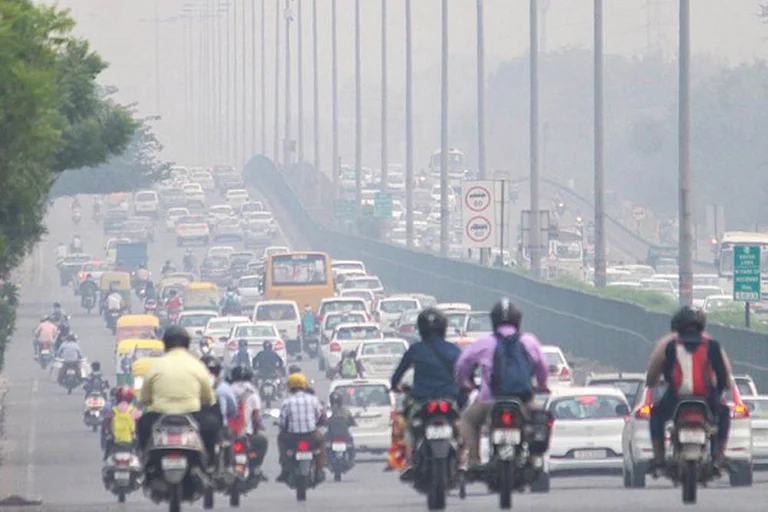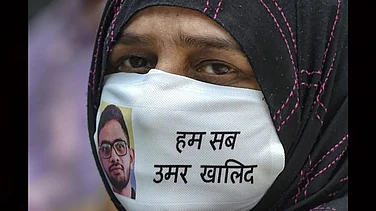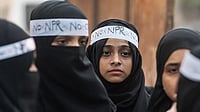Jyoti Waghmare is sitting on the footpath on the Union City Library Road in Nagpur, stirring a pot kept on a chulha. The hot breeze fans the flames and it sizzles over the pot. After a while, she lifts the pot and adds some chopped coriander to it. The dal is ready. She has already cooked a huge pot of rice. With five children—the eldest is 13 and the youngest is two—to raise on the footpath, beating the heat is not a priority. The children are running around in the hot sun, waiting for their mother to spoon them the first meal of the day. It is 12 pm, and the heatwave is unbearable.
Waghmare takes a quick bath in a makeshift bathroom behind a wall of synthetic saris. She dresses up in a printed salwar kameez, combs out her hair, puts sindoor in the parting of her hair and on her forehead. Sitting down in front of a small altar at the foot of a tree and decked up in red and green finery, she prays for her family’s well-being. “Every day, I ask Bholenath and Durga Maa to give us a roof over our heads. We are homeless, and I have lived on this footpath since childhood. We are poor but we need some dignity. This year, it is unbearably hot,” Waghmare tells Outlook. After the family has eaten, they will move to a shadier place under the trees on the other side of the road.
ALSO READ: Poetry: Letter From A Former Cook
Raju Solanki, 22, lives on the same footpath some metres away with his wife Bharati and four children. The eldest is seven years old and the youngest is six months old. Solanki sells painted cut-glass stands for households. These are priced from Rs 750 to 1,200 a piece. He earns about Rs 6,000-7,000 a month. “I was born on this footpath, and have lived here my entire life. Due to the extreme heat, we are all ill. We have stomach problems and headaches. The children get nosebleeds. Our bodies are covered in rash,” says Solanki. Waghmare too complains of headaches and dizziness. “I have to be in the sun when I do the chores. We fall ill all the time. When we are ill, we lie down in the shade, drink water and move around when we feel better. My husband is a daily wager and we do not have money for medicines,”
says Waghmare.

Vidarbha has been reeling under severe heatwave conditions since mid-March. The region has had four heatwaves so far. While the first heatwave hit the state on March 11 and continued till March 19, the second lasted from March 27 to April 12. The third heatwave began on April 17 and lasted until April 20. According to a source at the India Meteorological Department (IMD), this is an uncommon occurrence. Vidarbha and Marathwada face severe heatwaves lasting for longer durations as both these regions experience more extremely hot days than Central Maharashtra, another hot belt.
ALSO READ: Dante’s Peak: Heatwave Horror In Photos
Lack of pre-monsoon showers has also led to an increase in the maximum temperatures in the Vidarbha region. Maharashtra has recorded a 63 per cent deficit rainfall from March 1 to April 26. The IMD had warned of continued heatwave conditions in the Vidarbha region till April end. A total of 375 people were affected by heat strokes this year, say Maharashtra Health department officials. The ongoing heatwave has claimed 25 lives till now this year, across the state. Of these fatalities, 15 were from Vidarbha—11 in Nagpur, three in Akola and one in Amravati districts. According to the Maharashtra Health Department, these figures are the highest in the past seven years. In 2016, there were 19 heatwave deaths, 2018 had two deaths and 2019 nine deaths.
Temperatures in the Vidarbha region started soaring mid-March onwards. By mid-April, the temperatures touched 44°Celsius across the region. Post-April 19—which was a very hot day—all 11 districts in Vidarbha recorded temperatures above 40°Celsius. The findings by the Regional Meteorological Centre in Nagpur reveal that on April 19 Akola was the fourth-hottest place in the world, Chandrapur was in fifth position, Wardha stood at seventh and Brahmapuri at eighth. An IMD advisory during the mid-April heatwave asked citizens to exercise extreme caution when stepping out of the house: “If outside, cover your head using a cloth, hat or umbrella. Take special care of the elderly, children, sick and the overweight, as they are more likely to become victims of excessive heat. Also, traditional remedies like onion salad and raw mango with salt and cumin can prevent a heat stroke.”

By April 29, all the 11 districts were reeling under a severe heatwave. Chandrapur was the hottest in the region at 46.6°C, followed by the Naxal-dominated Brahmapuri at 46.3°C. At the Maharaja Bagh Zoo in Nagpur, the extreme heat was making the animals irritable. The steady stream of visitors to the zoo added to their discomfort, says Sanjay Gidam, caretaker at the zoo. “Even this heatwave has not deterred people. They crowd in front of the enclosures, make loud noises to draw the animals out of their rooms, throw stones and do all sorts of things, which irritate the animals. They are wild animals but the heatwave affects them,” Gidam tells Outlook. All the enclosures have water ponds. But the animals prefer the shade of the thickets and bushes growing in the open space of the enclosures. Huge desert coolers that constantly fan out cool breeze are kept behind the cages of the tigers, leopards and bears. Gidam also sprays water into their cages to lower the temperatures. “I move around the zoo and make sure even other animal is comfortable,” says Gidam, wiping beads of sweat from his face, neck and hands. Gidam personally gets no relief from the heatwave while trying to keep the animals cool.

Nagpur is home to a growing concentration of slums. Migrants from Madhya Pradesh, Gujarat, Rajasthan and Uttar Pradesh, have all settled here. While some are new entrants, there are others who have lived in these slums all their lives. Located cheek by jowl in congested lanes, these hutments—some built with tin sheets for roofs and walls, while others with mud walls and tin roofs—gleam in the unrelenting rays of the sun. Due to the heat emanating from the tin roofs and walls, the entire slum area gets heated up, say residents. So intense is the heat that the feet get burnt through the footwear.

Slum dweller Sonali Chipalkati works at a papad-making unit. The unit gives her the raw material, which she brings home, rolls out into palm-sized papads spread out on old saris and dried under the sun. After this, these are packed into plastic pouches and handed to the unit that sells it under their brand name. Sonali earns Rs 200 for 300 palm-sized papads. However, since March—after the heatwave peaked—Chipalkati and the other women at the unit have not been able to do much work. “A majority of us are daily wagers, while the rest work in small-scale industries. We are losing out a lot of money in these months as it is not possible to work after 12pm when the heat becomes unbearable,” says Chipalkati. “Our houses are very small. There is no space for fans. We sit under trees till evening, and then go inside our houses to cook and come back under the trees. The men sleep outside the houses, while the women and children sleep inside. It gets very hot at night,” she tells Outlook.

About 150km away from Nagpur, in Mowad village, farm labourer Sangeeta Ouike sits outside her tin-roofed house sewing her son’s torn pants. Her old mother occupies the wooden cot behind her. Further away from the cot is a makeshift kitchen with a large chulha. Due to the increasing cost of LPG cylinders, Ouike moved to cooking on the chulha, which she says is cheaper and faster. “In winters, we cook once a day and eat throughout the day. These days, the food gets spoiled very easily. I have to cook twice a day. We eat lunch and dinner,” Ouike tells Outlook. Due to the heatwave, chapatis are only made at dinner time, while rice is the preferred carb during the day. “Since vegetables are very costly, we eat the hens we rear. Though we suffer from many heat-related health problems, we never compromise with our food. It has to be very spicy, oily and pungent,” says Ouike. Mowad lies in the heatwave red zone. “It is difficult to sit inside or outside the house. The body gets so hot, it feels like we are on fire. The children suffer the most,” says Ouike.
Her 250 sq ft house is home to 10 members, including children. She fetches about 20 huge vessels of water for the family’s daily requirements. Each vessel has the capacity to hold 10 litres. During each trip, she balances two such vessels of water—one on her head and the other on her hip. She gets paid Rs 150 a day as a farm labourer, but during the heatwave she gets paid only half, as work concludes at 12 pm. Power outages are common across Vidarbha. For four days a week, the power is disconnected from 6am to 8pm, and there is no power from 8pm till 6am for the remaining three days.
Speaking to Outlook, agricultural officer Kunal Thakur points out that heatwaves have reduced productivity and production capacity. “The irrigation requirement has increased. More water is needed to keep the soil hydrated. The soil character is changing; it has become drier and more powdery. As farmers are unwilling to experiment, the cropping pattern has not changed much,” he says. Everyone in this region covers their head and face with white, cotton scarves. A majority, including women, wear full-length shirts or overcoats, cotton gloves and socks.
With no reliable means to beat the heat, the poor and the homeless continue to suffer its ill-effects.
(This appeared in the print edition as "Withering Heights")
ALSO READ
Haima Deshpande in Nagpur


























